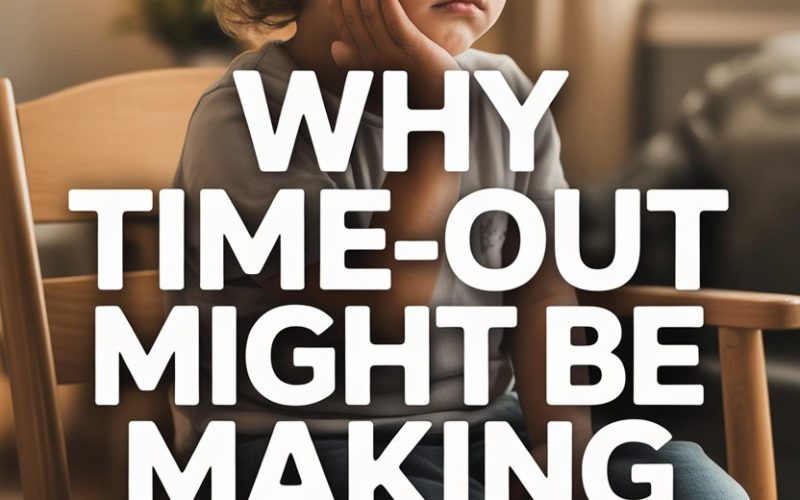If you’ve ever watched your child glare at you from the “naughty chair” with the simmering rage of a tiny supervillain, you may have wondered: is this really working?
Time-out has been a parenting staple for decades—almost as inevitable as stepping on stray Lego.
But for many families, the results are…well, not exactly the calm, reflective children the manuals promised.
Let’s chat about why time-out might be backfiring, and what’s actually going on when you send your little one to stew in the hallway.
What Time-Out Really Teaches
Time-out was meant to be a gentle, non-violent alternative to smacking—a chance for kids to cool down and “think about what they’ve done.”
Sounds ideal, right? Except when you peek behind the curtain, what time-out often teaches is less about reflection and more about isolation.
According to a study from the University of Michigan, children don’t magically develop remorse or new skills while parked on that step.
Often, they just feel rejected or confused. “Why did Mum suddenly stop speaking to me over a squabble with my brother?” (Or, if your house is like mine, the squabble was about a banana. Kids…)
The Power of Connection
Children’s brains aren’t wired to self-soothe in isolation. When their big feelings erupt, what they need most isn’t solitude—it’s connection.
Dr. Daniel Siegel, author of No-Drama Discipline, explains that kids regulate their emotions through supportive interactions with their caregivers.
Sending them away at their most vulnerable moment? That’s a bit like tossing someone a life jacket after they’ve already swum to shore.
Many parents report that, after repeated time-outs, their children seem angrier, more clingy, or just plain sneakier about their misdeeds.
Turns out, feeling banished doesn’t foster cooperation. Who knew?
Why Time-Out Can Escalate Battles
Picture this: your toddler has just walloped their sibling with a toy dinosaur. In swoops the time-out.
But instead of calming down, your child’s protest kicks into high gear. Cue shrieking, door thumping, and an Oscar-worthy performance of “I don’t caaaare!”
That’s because, for young children, big feelings are scary. Sending them away with those feelings can amplify their distress, not help them manage it.
According to developmental psychologists, time-out can actually trigger the brain’s threat response—fight, flight, or freeze. All it takes is a few rounds for kids to learn that expressing emotions gets them exiled, so they might bottle things up instead.
And nothing says “future therapy topic” like that.
The Sneaky Side Effects
Ever notice that your child seems to save their “worst” behaviour for you? That’s not because you’re doing it all wrong. It’s because home is where they feel safe enough to let it all hang out.
But if time-out is the main response, children may stop bringing their problems to you.
They might fib rather than face another banishment. Some even start internalising the idea that they’re a “bad kid.” According to child development experts, the message isn’t always “what you did was wrong,” but “you are wrong.”
Gulp.
What Actually Works: Connection Over Correction
If time-out is off the menu tonight, what’s a busy parent to do? No one wants pint-sized chaos running the show.
The answer isn’t letting kids run wild, but shifting from punishment to teaching. Instead of sending them away, try a “time-in.”
This means you invite your child to sit with you, breathe, and calm down together. It’s not about ignoring the behaviour—it’s about showing you’re still their safe person, even when they’re struggling.
Impossible, you say? Try it during a minor meltdown first. Sit quietly, offer a cuddle (if they’re up for it), or just say, “I’m here when you’re ready.”
Over time, you’ll be amazed at how often a little connection short-circuits the drama.
Repair, Don’t Repeat
After the storm passes, revisit what happened—without lectures. Ask, “What were you feeling when you grabbed the toy?” Really listen.
Often, the “why” behind behaviour isn’t as diabolical as it seemed mid-tantrum.
Work together to brainstorm solutions for next time. “If you want the dinosaur, what could you do instead of clobbering your brother?”
Bonus points for silly suggestions. Yes, even “ask the dinosaur politely.”
Model apologising and making amends, and invite your child to join in. This isn’t about forced “sorrys”—it’s about empathy. According to a Parent Coach, children learn to repair relationships by seeing it in action.
Boundaries, But With Compassion
Ditching time-out doesn’t mean you’re giving up on boundaries. Kids need to know the rules, and that you’ll enforce them.
If your child is hitting, step in promptly and clearly: “I won’t let you hit. I see you’re angry. Let’s find another way.”
Think of yourself as the calm captain, not the warden.
Consistency is key, but so is warmth. When you enforce limits with empathy, you become the lighthouse in their emotional storm—not the thundercloud.
What To Do When You’re About To Lose It
All this talk of empathy is lovely, but what about those days when you’re ready to book a one-way ticket to anywhere quiet? When you’re utterly exhausted and running on three hours’ sleep?
It’s completely normal to want your own time-out. In fact, sometimes the best thing you can do is step outside the room, take a few deep breaths, and regroup.
Let your child see you managing big feelings too: “I’m feeling overwhelmed. I need a minute to calm down, then I’ll help you.”
Modelling self-regulation is one of the best gifts you can give your child—and yourself.
Making a Change Without Guilt
If you’re reading this and feeling a wave of parental guilt because time-out has been your go-to, join the club.
Every parent tries strategies handed down by well-meaning relatives, teachers, or the latest parenting book. When those strategies start to feel counterproductive, you get to change course.
Repair isn’t just for kids. Next time things go pear-shaped, a simple, “It seems like time-out isn’t helping us lately. I want to try something different,” is all it takes to reset.
Kids are wonderfully resilient. You’re not expected to be perfect—just present. And probably caffeinated.
Why This Matters More Than Ever
Parenting trends come and go (raise your hand if you survived the sticker chart era), but children’s need to feel safe, seen, and soothed is universal.
Research into attachment theory shows that kids who feel connected during tough times are more likely to develop resilience, empathy, and self-control over time.
And the bonus? You’ll find your relationship with your child grows stronger—not in spite of the tough moments, but because of how you handle them together.
The Chair Isn’t the Enemy—Disconnection Is
Time-out doesn’t have to be a parenting villain, but it’s worth asking: is it bringing you and your child closer, or pushing you apart? If the answer is “apart,” even a little, maybe it’s time for a new tack.
Tonight, try pausing in the heat of the moment, offering a hand or a hug, and reminding your child you’re on their team.
The next time you’re tempted to haul out that naughty chair, remember—sometimes the best seat in the house is right next to you, listening and loving, no matter what.
Now, if only it worked on teenagers. (But that’s another feature.)





